 Situated as we are on the temperate coast, we make a favoured destination for birds. Year-round we are busy with visiting birds drawn in by the excellent habitat for breeding, or for the frost- and snow-free wintering grounds. The seas have proved bountiful locally and sustain large colonies of breeding seabirds.
Situated as we are on the temperate coast, we make a favoured destination for birds. Year-round we are busy with visiting birds drawn in by the excellent habitat for breeding, or for the frost- and snow-free wintering grounds. The seas have proved bountiful locally and sustain large colonies of breeding seabirds.
We are, however, not immune from the all too visible effects of climate change. For several years now the sand eel population has failed to thrive, leading to dramatic seasonal failures of the seabirds dependent on these wee fish. Other seabirds, like Gannets, that dive for bigger fish have gone from strength to strength. Gannets established a very accessible colony on Noup Head, Westray five years ago and there have been reports of gannets nesting on the Horse of Copinsay this year. Fingers crossed! This might be the start of a brand new colony.
Inland populations fluctuate, but one success story has been the Greylag Goose who’s numbers have gone from an uncommon visitor 25yrs ago to 80,000 over-wintering and a resident breeding population of tens of thousands. Let’s have a look over the birding year in Orkney, starting with the depths of winter and New Year.
DEEP WINTER TO SPRING
The high cliffs of the west coast provide a vantage point for some excellent sea watching when the winds have been driving in from the north and west. These conditions can provide Shearwaters, Skuas and all manner of unusual gulls. The majesty of the big Atlantic rollers crashing against the tall cliffs, not to fall back into the ocean but to be lifted up the cliff face like a waterfall in reverse is awesome to see. Bleak and empty as these huge rock faces seem, even now Fulmars will be casting an eye over the better looking ledges.
The main seabird interest at this time is on the sandy beaches and rocky shore line, with many of the local populations bolstered by visitors from the continent. Redshank, Turnstone and Oyster Catcher move through the rocks and weed. They may be joined on the rocks by flocks of Purple Sandpiper that have travelled from as far as Canada to winter here. Where the rocky ground turns to sand, the birds change again and we see the ubiquitous Ringed Plover joined by Dunlin, Knot ,Sanderling and Golden Plover. The larger waders, Curlew, Bar-tailed Godwit, Golden Plover and Redshank are well represented along the unspoilt shore. 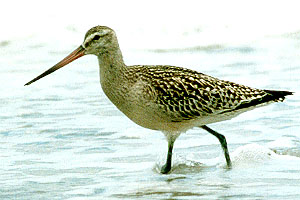
Off the shore, throughout winter, the sea is populated by thousands and thousands of wintering birds The sheltered waters of Scapa Flow, the barriers, calm bays and sounds of the isles provide havens for Slavonian Grebes, Great Northern Divers, Red Throated Divers, Black Throated Divers (if you’re lucky), Velvet Scoters or Surf Scoters for the fortunate.
Spectacular saw-billed diving ducks abound, with Red Breasted Merganser and the less common but often to be seen Goosander. Always around the coast you will see the flocks of Eider whilst Shag and Cormorants stand like sentinels on every rocky prominence. Throughout the depths of winter, huge flocks of Widgeon seem to be on every stretch of water be it salt or fresh.
Wintering ducks are everywhere and the small lochs excel. Easily viewed, accessible and numerous, you could manage to see Mallard, Teal, Tuffted Duck, Widgeon, Shoveller, Pochard, Scaup, Longtailed Duck, Ruddy Duck, Goldeneye and Shellduck This is before you take in all the sea ducks!!. On any day, there is always a real chance to find a rare visitor like Gargany or American Widgeon.
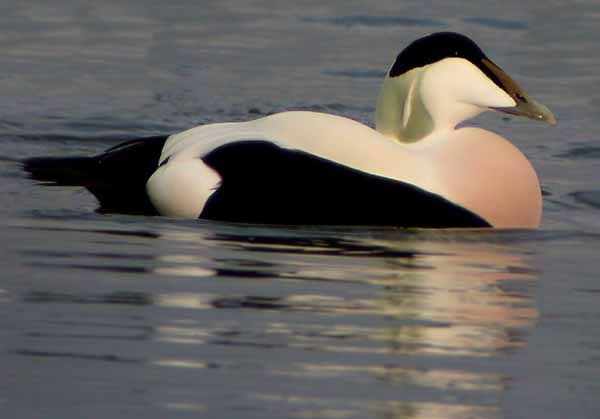
All too soon the days start to stretch and winter’s grip starts to ease. The pasture-land that had held the abundance of Curlews and huge flocks of Golden and Green Plover begin to fall silent with the Golden Plover the first to go.
.
EARLY SPRING TO LATE SUMMER
The easing of winter and the lengthening days spurs the population to begin it’s dispersal to the favoured breeding grounds. Some of the wading birds like Sanderling, Bar-Tailed Godwits, Ringed Plovers and Curlew may head to Russia and east to Siberia; others to points north and east like the high Artic, Iceland or Greenland. Redwings, Greylags and Whooper Swans return to Iceland and Greenland. Some Great Northern Divers and Purple Sandpipers head as far away as the Canadian coast and lochs. Soon the huge flocks of wild-fowl move away; the waders leave the fields and the sandy shore is once again strangely quiet.
The end of February and start of March is the calm before the flood. The first of the birds to return to breed are the raptors. Short-eared owls return from the Low Countries and the Hen Harriers numbers start to swell. Peregrine and Merlin become slightly more visible. The birds of prey begin spectacular courtship rituals with sky-dancing Harriers one of the bird world’s most impressive sights. Their aim is to breed as early as possible to take advantage of the incoming bounty to feed their young. 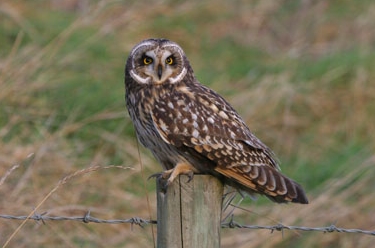
Spring is the most exciting time for us, as we never know what unusual migrating birds will stop off to feed and rest. Winds from the south and east divert the continental flow of migrants as they fly north. If they are pushed out over the North Sea we can find ourselves inundated with big falls of resting, feeding migratory birds. On such days it’s down tools and out with the binoculars as once again Orkney’s position provides us with a host of avian delights. As the March winds recede the air once again fills with the delightful sound of bird song. Everywhere love is in the air. Farm pastures abound with Skylarks. Every scrap of ground that can hold a territory is hotly contested.
The Meadow Pipits’ continual displays are everywhere. Often they are hotly pursued by Merlin, Peregrine, Harriers and even Short-eared Owls. The weeks pass by and the breeding season is soon in full flow. Everywhere is alive with birds. Curlews bubble and displaying Lapwings tumble about the sky.
In the hills Red Grouse call. The patches of willow-scrub and gorse that pepper the hills now hold Willow Warbler, Sedge Warbler and Stonechats, along with Greenfinch and many other small passerines, while the sound of Snipe drumming will often fill the air overhead. Looking over the countryside it seems that it could not get any busier - but from mid May the seabirds start to arrive for another season.
.
From bare rock, the cliffs start to be colonised once again. An army of Auks begins to arrive for yet another determined effort to breed. Guillemots take to the high ledges, cramming themselves on, shoulder to shoulder. Razorbills prefer more solitary ledges. Kittiwakes build up their nests. Along these high cliffs you can find the most prized of the sea birds; the Puffin. On the mainland they nest in small numbers at Marwick, the Brough of Birsay and Mull Head. They can also be found in a spectacular and accessible colony on Westray called Burrian Castle. Soon the magnificent seabird cities for which Orkney is renowned become occupied. Even with the poorer numbers and scarcity of sand eels of recent years, the nest sites and ledges fill to produce the endless drama of multi-story life.
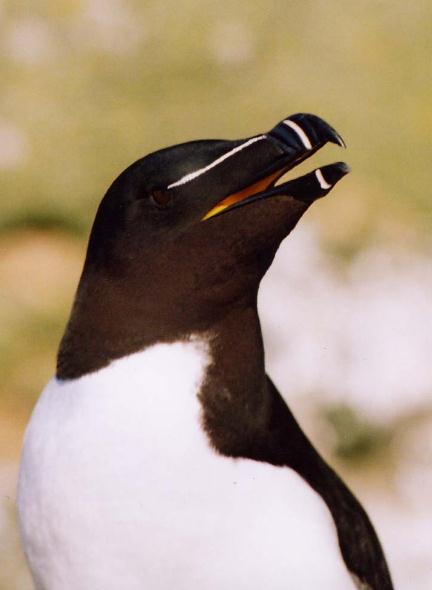
Along with the auks come the predators, timing their breeding cycle to that of their prey. The cliff-dwellers soon have to run the ‘gauntlet of death’, with Greater Black-backed Gulls and Ravens willing to snatch an egg or young chick from the cliff face. Bonxies (Great Skua), the agile thugs of the cliffs, mix freely with the graceful and deadly hunters, the Arctic Skua. They can out-manoeuvre most and will snatch birds out of the air.
Bonxies are kleptoparasites and will harass birds returning with food so severely that the victim is forced to regurgitate the food load its carrying for its partner or chicks to make its escape. Often the aggressor won’t even bother with this and kills the bird by knocking it out of the sky and drowning it. This behaviour gives Bonxies a bad press but they are every bit as impressive as their more glamerous Raptor cousins. Even avoiding these aggressors, there is always the chance of falling victim to a fast diving Peregrine Falcon. The cliffs are an area of fascinating and unending drama.
These high cliff sites are not the only seabird sites though. Both
Bonxies and Arctic Skua breed here on Orkney. The Bonxies breed on
moorland and in a huge colony on Hoy, Arctics in pairs on the coastal
moorlands. The Arctic Skua is Britain’s rarest breeding seabird and a
gem to see. Also in colonies on the coasts and moors are the other
gulls; Common Gull, Black Headed Gull, Lesser and Greater Black-backed. Terns move their colonies around, choosing different locations every season. Last year they did really poorly and we are hoping for more success next season.
On Orkney we have three types of breeding Tern; Common, who’s name is a bit of a misnomer as they are decidedly not so common, Artic Terns (the nosiest) and also the most impressive flyers - they will have travelled from the
furthest reaches of South Africa or even Australia to return to these shores. Finally, over the last couple of years, a few Little Terns have started to breed and hopefully this might be the start of a new colony for these locally rare, elegant and feisty little birds.
As high summer moves on everywhere seems alive with birds feeding young; fledglings often move around dangerously in the open. Fence posts provide a vantage place for adults to watch out over young chicks, The lochs now start to fill with proud parents trailing their young. The RSPB estimates there are over a million breeding birds across Orkney; from the abundantly common to the exotic and rare.
Some of the last to produce young are the internationally famous Red Throated Divers These superb divers are easily seen feeding on the sea. The lochans they breed on are too acidic to support much life, and they regularly feed on the sea adjacent to the breeding sights; thus giving great opportunities to see them without compromising their nesting area. A hide exists in the hills of Evie, overlooking a nesting site. This gives great, if distant, views. If you are there at the right time though, you may be lucky enough to witness the courtship displays!.
AUGUST TO OCTOBER
The endlessly light days begin to shorten and with the nearing end of summer things fall quiet; the first birds lead their young away for their first migration. Soon numbers start to drop and migration is underway. This heralds the exciting possibilities of rare and unusual birds making unscheduled stops for food and rest.
Local and international internet forums such as birdforum.net or orkbird (a yahoo group) provide up-to-date sightings and can help you stay ahead of the game in the search for rare and unusual migrants.
OCTOBER TO DEEP WINTER
During this time the winter visitors start to return and the seasonal change is confirmed with the first great skeins of graylag geese arriving from Iceland.
The occupation of the fields and shore now starts to change. Thrushes from the northern climes; Redwings and Fieldfares, start to dominate the open spaces. Flocks of waders start to swell with incomers - Lapwing, Redshank, Curlew and Golden Plover increase; sometimes to flocks of a thousand birds or more.
The shoreline now sees a huge increase in activity, as flocks of Dunlin and Knot scurry around between Ringed Plover, Turnstone, Oyster Catcher and Curlew. Searching over cold stubble fields can produce interesting mixed finch flocks swollen with European visitors like Reed Bunting, Redpoll or Brambling. Snow Buntings also head here for the milder winters and flocks of a hundred or more are not too uncommon.
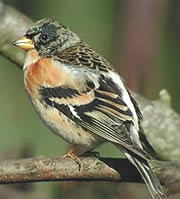 The weather is markedly colder and harsher now. The seas fill with returning Widgeon, Tufted Duck and Long-Tailed Duck being quite obvious. Even in Kirkwall you will find a mixture of wild ducks on the Peedie Sea; with Tufted, Scaup, Long-tailed, Goldeneye and Mergansers often seen. The lochs are now full of wild-fowl and the variety is astounding. All this is compounded as the Greylag Geese that have bred in the hills move about with their growing young.
The weather is markedly colder and harsher now. The seas fill with returning Widgeon, Tufted Duck and Long-Tailed Duck being quite obvious. Even in Kirkwall you will find a mixture of wild ducks on the Peedie Sea; with Tufted, Scaup, Long-tailed, Goldeneye and Mergansers often seen. The lochs are now full of wild-fowl and the variety is astounding. All this is compounded as the Greylag Geese that have bred in the hills move about with their growing young.
With the days growing shorter, we look to the weather patterns and the skies to bring us new birds. Even in the depths of winter there can be surprises and delights. Harsh, cold weather on the continent can push birds across the sea to seek shelter for a while. This winter we were blessed with a long-lasting and powerful storm that deposited good numbers of Little Auks around us. This tiny sea bird is one of the commonest and yet is rarely seen. They breed on the farthest north of the worlds’ seacliffs and spend the rest of their time over the open North Atlantic.
Recently we have just had a good irruption of Siskins. Flocks of Jackdaws arrived this week. Life here is always interesting for birders. We could have huge wading and shore bird arrivals. Flocks of Goldfinches, Waxwings and Bullfinches are not unknown. You never know what’s over the horizon. There is so much out there to explore and discover. I have barely scratched the surface of this treasure trove of birding wonders.
Enjoy.
Dafi for Orkneycrofts dec 2007










